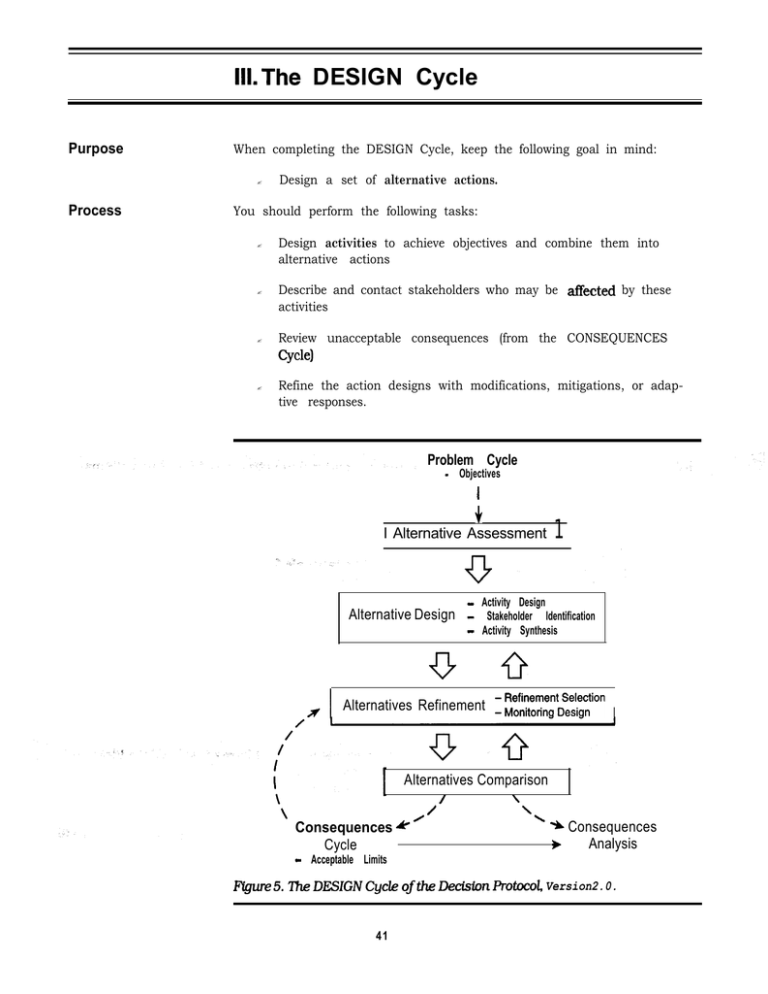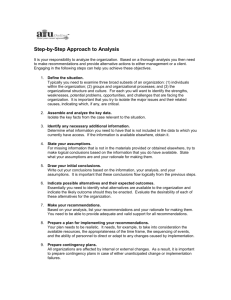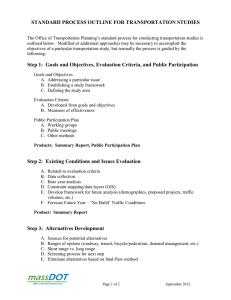IlLThe DESIGN Cycle Purpose
advertisement

IlLThe DESIGN Cycle Purpose When completing the DESIGN Cycle, keep the following goal in mind: ? Process Design a set of alternative actions. You should perform the following tasks: ? ? ? ? Design activities to achieve objectives and combine them into alternative actions Describe and contact stakeholders who may be affected by these activities Review unacceptable consequences (from the CONSEQUENCES Cycle) Refine the action designs with modifications, mitigations, or adaptive responses. Problem Cycle - Objectives I + I Alternative Assessment 1 - Activity Design Alternative Design - Stakeholder Identification - Activity Synthesis H I Alternatives Refinement I~$~~~\~$~“” I Alternatives Comparison / \ / -\ \ Consequences * ’ Cycle ’ * Consequences w Analysis - Acceptable Limits Rgure 5.TheDESIGNCycleoftheDecisionProtocol, 41 Version2.0. You should prepare the following products: Products .T-I. f ‘..‘ . . . .:’ I ? A description of the alternative actions ? A list of stakeholders ? A description of rationale for retming alternatives ? A comparfson of alternative actions. “._ The design process builds prototype action alternatives from sets of individual activities. These alternatives attempt to meet the objectives formed in the PROBLEM Cycle and will be evaluated in detail in the CONSEQUENCES Cycle. If you expect any of the alternatives to result in unacceptable consequences, the team returns to the DESIGN Cycle to refine or replace the activities that are responsible. Complete the DESIGN Cycle for each alternative action. Do not overdesign by adding in so many safeguards, standards, and mitigations that the action becomes unworkable or creates unacceptable risks or costs in other components. If there is already a proposed action, evaluate it by disassembling it into its activities. Try to understand how well they will meet the objectives and whether the activities will cause unintended consequences. Initial Assessment Questions Put a check beside each statement that is true about the action ahematives you have developed. For each question unchecked, work through the Core Question suggested or describe what should be done to bring this part of the alternative set yup to grade.” If you check fewer than half of the questions, work completely through the DESIGN Cycle questions. - The alternatives and the rationale for their design are clearly described. If this statement is not true, go to DESIGN Core Questions 7 and 13. 6 The alternatives are creative approaches to achieving multiple objectives and minimizing adverse consequences. If this statement is not true, go to DESIGN Core Questions 4 and 7. - The list of stakeholders who could influence or be affected by the proposed alternatives is complete. If this statement is not true, go to DESIGN Core Question 5. - The alternatives incorporate or at least have considered the ideas and suggestions of the stakeholders. If this statement is not true, go to DESIGN Core Questions 3,5, and 7. - The explanation of how the alternatives respond to stakeholder concerns is clear, logical, and complete. If this statement is not true, go to DESIGN Core Questions 4-7. 42 - The refinements for the alternatives are clearly described and justified. If this statement is not true, go to DESIGN Core Questions 8 and 9. - The range of alternative actions, including the no-action and status quo alternatives. is complete and balanced. If this statement is not true, go to DESIGN Core Questions 7 and 13. - Adaptive responses for uncertain events are completely and clearly defined. If this statement is not true, go to DESIGN Core Questions 8 and 9. - The alternatives incorporate multiple strategies to hedge against divergent predictions and guard against risks. If this statement is not true, go to DESIGN Core Questions 6 and 13. Plans for monitoring the activities are feasible and well organized. If - this statement is not true, go to DESIGN Core Question 10. - The alternatives contain provisions for preserving options for future managers. If this statement is not true, go to DESIGN Core Questions 11 and 13. DESIGN Core Questions Alternatives Assessment (Note: Record the zxunmaq of your discussions for DESZGN Core Questions l-3 in DESIGN Summwy Table 1, following DESZGN Core Question 3. DESIGN Core Question 1 What is the current or status quo management action? DESIGN Core Question 2 What is the no-action alternative? Describe the activities that make up the current or status quo alternative. This will provide a baseline against which to compare your design activities and refinements. Describe the no-action alternative, if different fi-om the status quo. ‘No action” could mean any of the following: ? The organization does not make a decision ? Current management continues ? Current management stops (that is. no activity1 ? Management returns to some former level ?? DESIGN Core Question 3 Something else. What, if any, actions have already been proposed? Describe any actions that have already been proposed. DESIGN Summary Table 1. Current and Proposed Action Descriptions (DESIGN Core Questions l-3) Activity Tvpe Current Action (status quo) (D- 1) No Action (D-2) Proposed Action (D-3) Activity type 1 .Activity type 2 44 Alternatives Design (Note: Record discussions for DESZGN Core Questions 4 and 5 in DESZGN Summary Table 2, following DESZGN Core Question 5.) DESIGN Core Question 4 What activities will accomplish specific objectives? An action is composed of a set of activities that address the objectives. For each objective or group of objectives set forth in the PROBLEM Cycle, identify activity types that could change the associated measures to the desired values. Define two or more activity options for addressing each objective. These may be different activity types or different levels, strategies, or approaches for the same activity type or modifications to ongoing management activities. If there is already a proposed action, show how the activities that comprise it would align with the measures in the objectives. Record results in DESIGN Summary Table 2 and locate activities on a map if appropriate. DESIGN Core Question 5 What stakeholders-public groups, organizations, consultative agencies, and individuals-have an interest in these activities? Identify who would be most concerned about each activity and describe their support, opposition, or neutrality. Consider experiences with similar projects as a guide. Consider stakeholders who are involved in the following ways: ? ? ? They could be directly affected by such an activity They hold attributes of the area or situation to be of special, unique, or symbolic value They might campaign to stop the activity. 45 - DESIGIY Summary Table 2. Activity Options (DESIGN Core Questions 4-5) Objectiive (measure value) 1 Activity options P-41 Activity TVpe Objective (measure value) 2 Activity TVpe Option A Option B Option C Stakelolders D-5) 46 Activity Type Activity TVpe (Note: Record the surnmcuy of your discussions for DESIGN Core Question 6 in DESIGN Summary Table 3.) DESIGN Core Question 6 How do the activities compare on their ability to meet objectives, cost, side effects, and other criteria? Rate each activity option on a scale of 0 to 10 (0 = unacceptable, 10 = best) for each of the criteria below. . Objective+How well will the activity meet the specific objectives? . Side eflects-How many unintended and unwanted consequences (side effects) could be created? What are these effects? . Cost-What is the additional cost, in dollar equivalents, of the effort, materials, supervision, and other resources required? . Stakeholder opinio*Will the stakeholders be supportive, opposed, or neutral? Does the activity raise new concerns? Do stakeholders believe that the activity will be implemented and monitored effectively? . Feasibility-Is the activity technically, physically, and logistically feasible? . lKanageriaZfle.xibility-How much flexibility will future managers have to respond to natural or human uncertainties, new information, or unexpected consequences? Can they modify, stop, or switch to another activity if the situation warrants it? . Funding-How likely is the funding for this activity given the current and expected state of the agency’s resources? 47 DESIGN Summary Table 3. Activity Comparison (DESIGN Core Question 6) Objectives Objective: Objective: Activity Activity Type: Activity Type: Activity options Activity Option A Activity Option B Activity Option A Ratings on Criteria (0 = unacceptable to 10 = best) Objectives Side effects cost Stakeholder opinion Feasibility Managerial Funding flexibility availability Other criteria Activity Evaluation and Rationale Activity considered in alternative (yes/No) Rationale for selection/ nonselection 48 .- Activity Option B DESIGN Core Question 7 What alternative actions (combinations of activities) could solve the problem (accomplish all objectives)? Construct proposed actions, which are different combinations of activities that could meet objectives, compromise among competing objectives, and minimize unwanted consequences. These alternatives should be feasible and different enough in approach and expected consequence to offer the deciding officer a reasonable range of choices. Strive for a relevant set of alternatives, not one “preferred” action stacked against a group of “straw men” that are obviously infeasible or unacceptable. Use DESIGN Summary Table 4 to build the alternatives by combining activities into actions. Activity types make up the rows: alternative actions, the columns. For each column, select one of the options for each activity type from DESIGN Summary Table 2. Assign a theme or name to each action to show how it differs in approach from other actions. Check to see that the combination of activities makes sense and is feasible. When developing alternatives. consider the following: ? ? ? ? Stated objectives (PROBLEM Cycle) Other measures that might be outside acceptable levels (see the CONSEQUENCES Cycle) Stakeholder concerns and public conflicts Alternatives suggested by stakeholders that could address the stated problems or opportunities. DESIGN Summary Table 4. Alternative Designs (DESIGN Core Question 7) Activity Type (from DESIGN Summary Table 2) Alternative Action A: Alternative Action B: Alternative Action C: Activity type: Activity option: Activity option: Activity option: Activity type: Activity option: Activity option: Activity option: Skip ahead and complete the CONSEQUENCES Cycle for each alternative. If unacceptable consequences are expected, consider refining or dropping the altemativefromfurther consideration. Zf you want to rem an alternative, move on to the next section below. 49 Refinement DESIGN Core Question 8 ’ (Note: Use DESIGN Summary Table 5, following DESIGN Core Question 12, when answering DESIGN Core Questions 8-l 2.) What activities do you want to refine? List activities (in DESIGN Summary Table 5, following DESIGN Core Question 12) that will cause one or more measures to be at unacceptable levels or raise serious doubts about the alternative’s ability to meet the objectives. Also consider activities that are controversial with stakeholders. DESIGN Core Question 9 What refinements could improve the design of the alternative? For each activity to be refined, describe modifications, mitigations, or adaptive responses as reiinement options. Modifications are structural changes in the activity itself. Mitigations are additional activities or standards to forestall or compensate for the activity’s consequences. Adaptive responses are planned shifts in activity in response to adaptive signals. For each adaptive response, indicate the future event or monitoring signal that would prompt a response and the range of options future managers may have to deal with. If team members or stakeholders differ in their recommendations of refinements or there is great uncertainty about the activity options, try multiple activities and test how they might work with monitoring cues and adaptive response plans. List the reiinements DESIGN Core Question 10 for each alternative in DESIGN Summary Table 5. What consequence monitoring will be needed to implement these activities? Consider the following: ? DESIGN Core Question 11 What information or indicators will reliably determine whether a measure value is outside its acceptable range and whether additional management action is needed ? The appropriate scale for this information ? How often the information should be collected ? What level of precision you require ? Legal mandates to monitor particular attributes. How do the refinements compare on their ability to meet objectives, cost, side effects, and other criteria? For each activity to be refined, compare refinement options. Rate each on a scale of 0 to 10 (0 = unacceptable, 10 = best) for each of the criteria below. 50 Consider the following: DESIGN Core Question 12 . Obfective+How well will the refinement improve the action’s ability to meet the objectives? . Side enIts--How many unintended and unwanted consequences (side effects) could be created by this refinement? What are these effects? . Cost-What is the additional cost, in dollar equivalents, of the effort, materials, supervision, and other resources required? Include expected monitoring and adaptive response costs. . StaIcehoIder opinicr+Wffl the stakeholders be supportive, opposed, or neutral? Does the refinement raise new concerns? Do stakeholders believe that the refinement will be implemented and monitored effectively? . Feasibilitg-Is cally feasible? . ManageriaZJZexibiZi~How much flexibility will future managers have to respond to natural or human uncertainties, new information, or unexpected consequences? Can they modify, stop, or switch to another activity if the situation warrants it? . Funding-How likely is the funding for this refinement given the current and expected state of the agency’s resources? the refinement technically, physically, and logisti- Which of the refinements will you include in the final set of alternative actions? Choose one refinement or a combination of refinements for each activity that meets the criteria in DESIGN Core Question 11 and that will make the action acceptable. Eliminate refinements that do not modify consequences to acceptable levels. Describe your rationale for making these selections. Describe why you eliminated the reftnements not chosen. Show this work in DESIGN Summary Table 5. DESIGN Summary Table 5. Alternative Refinements (DESIGN Core Questions 8-12) Alternative -. action Activity Activity A Refinement options Activity B Refinement Option A Refinement Option B Refinement Option A Refinement Option B Ratings on Criteria (0 = unacceptable to 10 = best) Objectives Side effects cost Stakeholder opinion Feasibility Managerial Funding flexibility availability Other criteria Refinement Choices and Rationale Refinement (Yes/No) selected Rationale for selection/ nonselection - 52 Alternatives Comparison (Note: Use DESIGN Summary Table 6, foUowi.ng DESIGN Core Question 14 when answering DESZGN Core Questions 13 and 14.) DESIGN Core Question 13 How do the refined alternative actions, the status quo, and the no-action alternatives compare? Cycle back to DESIGN Core Question 7 and refine the descriptions of the alternative actions. Cycle forward to the CONSEQUENCES Cycle to modify your predictions or expectations of the consequences of the refined actions, considering performance in meeting objectives. minimization of adverse effects, cost, feasibility, and other criteria. Display the alternatives and their expected consequences for each objective and side effect measure in DESIGN Summary Table 6 (after DESIGN Core Question 13). DESIGN How might you combine features of the alternatives into a hybrid Core Question 14 action that could outperform those in the existing set? DESIGN Summary Table 6. Alternatives and Consequences Summary (DESIGfiCore Questions 13-14 and CONSEQUENCEs Cycle results) Future Consequences Measure Values Measures (PROBLEM and CONSEQUENCES Cycles) Current Action (if different from no-action) (D-l) No Action (D-2) Alternative B Alternative A Combined or (after refinement) (after refinement) Hybrid Alternative (D-7, D-l 2) (D-7, D-l 2) (D-l 4) Objectives Measure 1 Objectives Measure 2 Side Effects Measure 1 Side Effects Measure 2 53 _ Audit Questions Recheck the Initial Assessment Questions in this cycle. If you are unsatisfied with any of the answers, return to the appropriate Core Questions or suggest other improvements. See Appendix A. Team Leader Tips and Tools, for process suggestions. . . : . I . . 54




